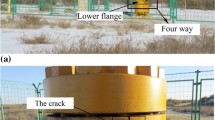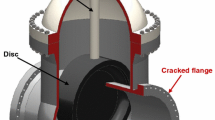Abstract
A failure analysis was conducted on two flange components that experienced a crack. Crack was found in the vicinity of the weld toe of the component. The flange components are fabricated from ASTM A672-65 CL22 material, and their metallurgical background corresponds to class 22. The flange component was part of the cooling water return system, which also comprises of a carbon steel flange and pipe. The analysis was presented from macro and micro fractography observations, microstructure observation in the vicinity of the crack, chemical composition, and hardness test. The microstructures of the welded region composed of Grain Boundary Allotriomorphic and ferrite, which are expected to favor the formation of cracks and decrease fatigue life. Crack was determined to be transgranular cracking and indicated brittle-to-ductile type of fracture. The HAZ region has a slightly higher hardness than the base pipe and weldment regions. However, hardness value and brittle-to-ductile fracture mode have no significance to the hydrogen embrittlement phenomena. Based on the analysis, it is concluded that the crack is the result of fatigue failure owing to possible stress concentration at the weld toe. By identifying the origin of a crack, similar failures can be prevented, and the service life of engineering components can be extended.







Similar content being viewed by others
References
P.A. Alaba, S.A. Adedigba, S.F. Olupinla, O. Agboola, S.E. Sanni, Unveiling corrosion behavior of pipeline steels in CO2-containing oilfield produced water: towards combating the corrosion curse. Crit. Rev. Solid State Mater. Sci. 45(3), 239–260 (2020)
L.S. Moiseeva, Carbon dioxide corrosion of oil and gas field equipment. Prot. Metals. 41(1), 76–83 (2005)
B. Wang, L. Xu, G. Liu, M. Lu, Corrosion behavior and mechanism of 3Cr steel in CO2 environment with various Ca2+ concentration. Corros. Sci. 136, 210–220 (2018)
A. Farhadian et al., Efficient dual-function inhibitors for prevention of gas hydrate formation and CO2/H2S corrosion inside oil and gas pipelines. Chem. Eng. J. 431, 134098 (2022)
F. Nasirpouri, A. Mostafaei, L. Fathyunes, R. Jafari, Assessment of localized corrosion in carbon steel tube-grade AISI 1045 used in output oil-gas separator vessel of desalination unit in oil refinery industry. Eng. Fail. Anal. 40, 75–88 (2014)
J. Nogara, S.J. Zarrouk, Corrosion in geothermal environment: Part 1: fluids and their impact. Renew. Sustain. Energy Rev. 82, 1333–1346 (2018)
M.D. Chapetti, T. Tagawa, T. Miyata, Ultra-long cycle fatigue of high-strength carbon steels part I: review and analysis of the mechanism of failure. Mater. Sci. Eng. A. 356(1–2), 227–235 (2003)
F. Shen, B. Zhao, L. Li, C.K. Chua, K. Zhou, Fatigue damage evolution and lifetime prediction of welded joints with the consideration of residual stresses and porosity. Int. J. Fatigue. 103, 272–279 (2017)
X. Wang, Q. Meng, W. Hu, Continuum damage mechanics-based model for the fatigue analysis of welded joints considering the effects of size and position of inner pores. Int. J. Fatigue. 139, 105749 (2020)
V. Mazánová, V. Škorík, T. Kruml, J. Polák, Cyclic response and early damage evolution in multiaxial cyclic loading of 316L austenitic steel. Int. J. Fatigue. 100, 466–476 (2017)
Standard Specification for Electric-Fusion-Welded Steel Pipe for High-Pressure Service at Moderate Temperatures. ASTM A672/672M, ASTM Int., 96, 1–7 (2009)
Specification for Pressure Vessel Plates, Carbon Steel, for Moderate–and Lower-Temperature Service. ASTM A516, Sa-516/Sa-516M, ASTM Int., 06, 1–4 (2017)
C. Kanchanomai, W. Limtrakarn, Effect of residual stress on fatigue failure of carbonitrided low-carbon steel. J. Mater. Eng. Perform. 17(6), 879–887 (2008)
Z. Zhang, Quantitative characterization on fatigue fracture features of A6005 aluminum alloy welded joints. Eng. Fail. Anal. 129, 105687 (2021)
H.-H. Lai, W. Wu, Practical examination of the welding residual stress in view of low-carbon steel welds. J. Mater. Res. Technol. 9(3), 2717–2726 (2020)
S. Missori, A. Sili, Prediction of weld metal microstructure in laser beam welded clad steel. Metallurgist. 62(1–2), 84–92 (2018)
J.P. Oliveira, T.G. Santos, R.M. Miranda, Revisiting fundamental welding concepts to improve additive manufacturing: from theory to practice. Prog. Mater. Sci. 107, 100590 (2020)
M. Taghipour, A. Bahrami, H. Mohammadi, V. Esmaeili, Root cause analysis of a failure in a flange-pipe welded joint in a steam line in an ammonia plant: experimental investigation and simulation assessment. Eng. Fail. Anal. 129, 105730 (2021)
Y. Chen et al., Effects of microstructural inhomogeneities and micro-defects on tensile and very high cycle fatigue behaviors of the friction stir welded ZK60 magnesium alloy joint. Int. J. Fatigue. 122, 218–227 (2019)
J.P. Oliveira, T.G. Santos, R.M. Miranda, Revisiting fundamental welding concepts to improve additive manufacturing: from theory to practice. Prog. Mater. Sci. 107(2020), 100590 (2020)
M.K.B. Givi, P. Asadi, A. Heidarzadeh, K. Kazemi-Choobi, H. Hanifian, P. Asadi, Advances in Friction-Stir Welding and Processing, Elsevier, 2014
Acknowledgments
The authors wish to acknowledge the financial support for research grants from the Ministry of Higher Education, Malaysia (FRGS/1/2019/TK05/UMP/02/5) and Universiti Malaysia Pahang (RDU1901128 and RDU210380).
Author information
Authors and Affiliations
Corresponding author
Ethics declarations
Conflict of interest
The author(s) declared no potential conflicts of interest concerning this article’s research, authorship, or publication.
Additional information
Publisher's Note
Springer Nature remains neutral with regard to jurisdictional claims in published maps and institutional affiliations.
This article is an invited paper selected from presentations at the 6th Symposium on Damage Mechanism in Materials and Structures (SDMMS 2022), held August 16–17, 2022 in Kuantan, Malaysia. The manuscript has been expanded from the original presentation. The special issue was organized by Nasrul Azuan Alang, Norhaida Ab Razak, and Aizat Alias, Universiti Malaysia Pahang.
Rights and permissions
Springer Nature or its licensor (e.g. a society or other partner) holds exclusive rights to this article under a publishing agreement with the author(s) or other rightsholder(s); author self-archiving of the accepted manuscript version of this article is solely governed by the terms of such publishing agreement and applicable law.
About this article
Cite this article
Alias, J., Alang, N.A., Ahmad, A.H. et al. Failure Analysis of a Carbon Steel Pipe-Flange Component. J Fail. Anal. and Preven. 23, 490–496 (2023). https://doi.org/10.1007/s11668-022-01572-w
Received:
Revised:
Accepted:
Published:
Issue Date:
DOI: https://doi.org/10.1007/s11668-022-01572-w




